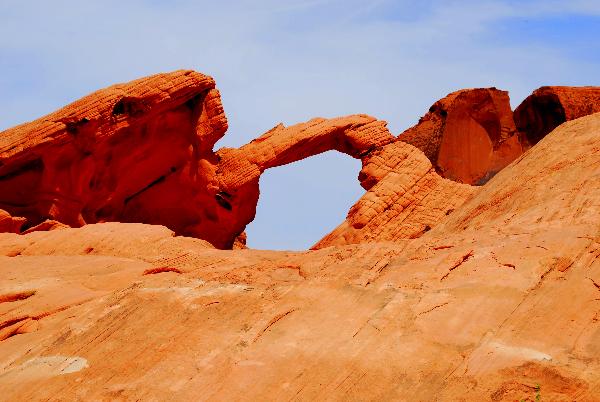This EarthCache will highlight perhaps the most easily accessible of the many arches in Valley of Fire State Park.

Here you will check out a natural arch formed in the Navajo Sandstone of Nevada's oldest state park. This is the same formation found in many other State and National parks of the southwest such as Red Rock NRA or Zion National Park. The red colors in the sandstone are a result of the minerals in the rock, principally iron oxides. This formation is believed to be the remains of a huge 150,000 square mile desert which existed in this region from about 192 to 178 million years ago. At the time of this great desert, the region itself is believed to have been about 8 to 17 degrees north of the equator.
By definition a natural arch is a rock exposure that has a hole completely through it formed by the natural, selective removal of rock, leaving a relatively intact frame. Almost all arches have quite a few different factors to which they owe their existence and this one is no different.
Some of the more important processes responsible for the formation of this arch are:
Chemical Exfoliation - Water that is in contact with rock will, over time, dissolve the lattice of fine crystalline grains that cement the larger grains of the rock together. In effect, the water dissolves the rock into grains which can then be removed either by the water itself, gravity, wind, or other mechanisms. This is one of the first steps in the formation of the arches in the park. Over time chemical exfoliation will create small caves and pockets in the rock which are often the beginnings of an arch.
Bedding Plane Expansion - Sandstone is a sedimentary rock deposited in layers with distinct boundaries known as bedding planes. Water seeping between the bedding planes will cause chemical exfoliation, and when temperatures drop low enough, freeze expansion. This often leads to the growth of a horizontal air gap between the layers of rock. In this way, the expansion of a bedding plane in a rock exposure can contribute to the formation of a natural arch.
Gravity - Over time loose blocks formed around the damage along the bedding planes gives way to gravity and falls out expanding the open space in the middle of the arch.
Wind - Strong winds can pick up small enough grains and pummel the surface of a rock exposure with them, in effect sandblasting the rock. Though not as relevant to the formation of the arch itself wind and the loose sediment driven by it play a definite role in the appearance of the arch by smoothing away the rough edges and rounding off the exposed surfaces.
There is a day use fee to enter the park. Please remain at the level of the road for your picture and do not climb or walk on the rocks.
To claim this as a find:
1. Post a photo of yourself and your GPS (from the level of the road) with Arch Rock in the background. (Optional but appreciated.)
2. Estimate the span (horizontal dimension of the opening) of the arch.
3. Estimate the clearance (vertical dimension of the opening) of the arch.
E-mail the answer to me for numbers 2 and 3 within a few days. Failure to comply with these requirements will result in log deletion.
Good luck and good caching.
- Rev Mike